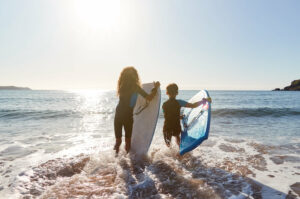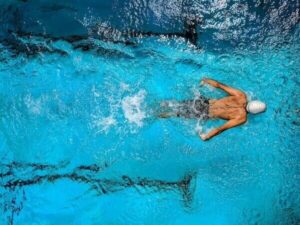Kayaking is, to put it mildly, not for couch potatoes. If you only like water for the scenery of the top surfspots, it might not be the best choice for you. It gets wild, wet, and cold. When speed, fear, and water team up against you, your wetsuit or drysuit becomes the most essential part of your gear. Well, the second most important, right after the kayak. But the point is: nothing gives you more feelings of safety and security in extreme situations than the right choice of clothing. Here’s how to find out which is the best drysuit or the best wetsuit for kayaking for you.
In this article, you will get answers to the following questions:
- What type of wetsuit can you use for kayaking?
- Do you need a special wetsuit for kayaking?
- What to look for in a wetsuit for kayaking?
- Can you wear a drysuit for kayaking?
- What are the advantages of a drysuit over a wetsuit when kayaking?
The Essentials for Kayaking: Drysuit, Wetsuit, and More
Kayaking is an adventure that calls for more than just excitement; it demands preparation. Whether you’re slicing through calm lakes or charging down white water rapids, having the right gear can turn your day from average to unforgettable. But where do you start? Let’s break down the essentials that every kayaker should know and love.
The Gear You Need for Kayaking
Believe me, you do not want to go kayaking unprepared! Just because it is a sunny warm day, that does not say anything about the water, that you will probably not only get to see from above — but from underneath your boat too. To reduce the risk of freezing, catching a cold, and never ever wanting to go kayaking again, the choice of the right gear is the first big step.
Here is a list of things you should get:
1. Your Lifesaver: The Personal Flotation Device (PFD)
Think of your PFD as your best on-water friend. It’s there to make sure that if you capsize or hit an unexpected wave, you stay afloat. And don’t worry—modern PFDs are far from bulky. They’re designed to move with you, offering a snug fit and maximum comfort. Trust me, once you’ve tried paddling with one, it’ll feel like second nature.
2. Wetsuit or Drysuit: The Big Question
This is where personal preference meets practicality. If you’re heading out in warmer weather or slightly chilly waters, the best wetsuit for kayaking might be your go-to. It hugs your body and traps a thin layer of water that your body heat warms up, keeping you insulated.
But if you’re like me and can’t stand being cold or plan on paddling in icy conditions, a drysuit is a game-changer. It keeps you completely dry, and with thermal layers underneath, you’ll stay warm and cosy even when the water temperature drops. If that didn’t quite settle your decision between wetsuit and drysuit for kayaking, the next chapter might give you the answers you need.
3. Footwear That Stays Put
Ever tried kayaking with soaked, slippy shoes? It’s not fun. That’s why neoprene booties or water shoes that drain well are a must. They’ll give you grip, warmth, and won’t shift around when you’re moving in and out of your kayak.
4. Stay Smart: Helmets and Safety Gear
If you’re taking on white water rapids or rocky areas, wearing a helmet isn’t just smart—it’s essential. Protect your noggin and paddle with peace of mind. Also, keep a whistle on hand; it’s a simple tool, but if you need to call for help, it can be a literal lifesaver.
5. The Mighty Paddle (and a Spare)
Your paddle is your kayak’s engine. Invest in one that suits your style, whether it’s lightweight carbon fiber for long distances or a more robust option for tackling rapids. Oh, and bring a spare paddle—because there’s nothing worse than drifting without one.
6. Dry Bags: Your Adventure’s Safety Net
Kayaking isn’t kayaking without a splash or two (or ten). But your essentials—like snacks, phones, and dry clothes—deserve to stay dry. A trusty dry bag will keep them safe, no matter how wild the ride gets.
7. Water and Snacks for the Long Haul
Trust me on this one: bring water and snacks. Whether it’s a high-energy bar or some trail mix, a little fuel goes a long way. Paddling can be surprisingly intense, and staying hydrated and energized makes a big difference.
8. First Aid: Better Safe Than Sorry
A compact, waterproof first aid kit is the kind of thing you hope to never need but will be glad to have. Pack it with the basics—band-aids, antiseptic wipes, and anything else you might need for a minor mishap.
5 Dos and Don’ts for Kayaking
Kayaking is a sport that’s as much about skill as it is about respecting nature and staying safe. Whether you’re paddling solo or with a group, understanding the basic rules and the essential dos and don’ts can make your time on the water safer and more enjoyable. Here’s how to approach kayaking with confidence and respect.
1. Preparation Matters
Check the weather, know the water conditions, and plan your route. A bit of prep goes a long way.
Don’t: Skip researching your paddling spot.
Do: Ask locals or experienced kayakers for tips.
2. Dress Appropriately
Dress for the water, not just the weather. A wetsuit or drysuit can make all the difference.
Don’t: Wear heavy cotton or jeans.
Do: Choose quick-drying, lightweight clothing.
3. Always Wear a PFD
A personal flotation device is a must. It’s your best safety asset.
Don’t: Assume swimming skills replace a PFD.
Do: Ensure it fits snugly before launching.
4. Respect Nature
Stay mindful of wildlife and keep the water clean.
Don’t: Disturb animals or their habitat.
Do: Leave no trace—pack out all trash.
5. Know Your Limits
Push yourself, but recognize when to stop.
Don’t: Ignore fatigue or warning signs.
Do: Listen to your gut and stay safe.
You feel ready to jump right into your Kayak and get the paddles swinging, but the one big question remains: Wetsuit or Drysuit? You will find the answer only one scroll away in our next chapter.
The Big Question: Is a Wetsuit or a Drysuit Better for Kayaking?
When it comes to kayaking, one of the most common questions is whether you should go for a wetsuit or a drysuit. The right choice depends on the conditions, the type of kayaking you’re doing, and your personal comfort.
Wetsuits are made from thick neoprene and designed to keep you warm by trapping a thin layer of water between the suit and your body. Your body heats this water, providing insulation.
Wetsuits are ideal for warmer waters, or for activities where you know you’ll be wet but don’t mind a bit of cold water around you. They’re also generally more flexible and allow for greater freedom of movement.
Drysuits, on the other hand, provide complete protection from water. Made from waterproof materials with seals at the wrists, neck, and ankles, a drysuit keeps you completely dry even when submerged. They’re perfect for colder waters or if you’re kayaking in unpredictable conditions where you might get fully immersed.
However, you’ll need to layer up underneath a drysuit for warmth, as it doesn’t provide insulation on its own like a wetsuit does.
When to Choose a Wetsuit
A wetsuit is a fantastic option for kayaking in warmer conditions where you want flexibility, comfort, and a good range of movement. The best wetsuits for surfing, wetsuits for triathlon or the best wetsuit for wakeboarding are THE best, because they offer exactly the range of motion the sport needs.
Here’s when a wetsuit is your best choice:
1. Warmer Water and Weather Conditions
If you’re kayaking in warmer climates or mild water temperatures, a wetsuit will provide the right amount of protection without overheating you.
Typically, wetsuits are great for water temperatures ranging from 60° F (15° C) to 75° F (24° C), making them ideal for spring and summer paddling, or in warmer coastal areas. They allow you to stay comfortable in the water without feeling like you’re overly bundled up, as drysuits sometimes can.
2. Shorter Trips or Moderate Paddling
Wetsuits are perfect if you’re planning short kayaking trips or moderate paddling in warmer weather, where you may get wet but won’t necessarily spend extended periods in cold water. A wetsuit will provide enough insulation to keep you warm and comfortable during a fun day on the water, but it doesn’t require the level of commitment or layering that a drysuit demands.
The answer to what to wear under a wetsuit is not too far from what to wear for layering underneath a kayaking wetsuit: You can wear neoprene underwear or fleece clothing but for cold conditions, a drysuit would be the much easier option.
3. Active Paddlers Looking for Flexibility
Kayaking often involves a lot of movement and paddling, and wetsuits excel in providing flexibility. The neoprene material stretches and molds to your body, allowing for full freedom of movement.
This makes them an ideal choice for active paddlers who need to stretch, bend, and twist without any restriction. Unlike drysuits, which can be bulkier, the best wetsuit for kayaking maintains a sleek and lightweight profile.
4. Moderate Water Immersion
A wetsuit is great for situations where you might occasionally get wet but don’t expect to be completely submerged for long periods. It traps water between your skin and the suit, and your body heat warms this water, keeping you insulated from the cold.
So, if you’re paddling in conditions where you could tip over or splash into the water now and then but aren’t going to be fully immersed, a wetsuit will keep you warm without overwhelming you.
5. Budget-Friendly Option
Compared to drysuits, wetsuits are generally more affordable. How long a wetsuit lasts lies in your hands, but if you’re on a budget and plan to kayak mostly in mild to warm weather, a wetsuit offers a cost-effective way to ensure you’re protected without breaking the bank. It’s a good choice for recreational kayakers who don’t need all the bells and whistles of a drysuit.
6. Simple Maintenance
Wetsuits, even the best wetsuit for kayaking, are often simpler to maintain than drysuits. They don’t require as much care to keep waterproof seals intact. As long as you know how to clean your wetsuit properly, rinse it out after each use and store it properly, a wetsuit will last for many kayaking adventures.
When to Choose a Drysuit
While there are cold water wetsuits, a drysuit is the ultimate choice when you’re facing cold water or extreme weather conditions. Here are the key situations where a drysuit becomes essential:
1. Cold Water Conditions
If you’re kayaking in cold waters (below 60° F/15° C), a drysuit is the better option for staying safe and comfortable. Unlike wetsuits, which rely on water trapped between the suit and your body for insulation, a drysuit keeps you completely dry, preventing water from coming in.
This is especially crucial for longer trips or times when you might be in the water for extended periods. The drysuit helps to trap your body heat more effectively, reducing the risk of hypothermia.
2. Extended Exposure to Cold Water
If you’re kayaking in conditions where you could be exposed to cold water for longer periods, such as during sea kayaking or white water kayaking, a drysuit is highly recommended. It provides a higher level of protection because it keeps the water from contacting your skin, unlike wetsuits that depend on a thin layer of water for insulation.
So, for long trips where you might spend hours on the water or face unpredictable weather, a drysuit ensures you’re fully protected.
3. Whitewater Kayaking or Rescue Situations
For white water kayaking—where you might flip, roll, or get thrown into fast-moving, cold rivers—drysuits are essential for safety. They provide full waterproofing, allowing you to stay dry even if you’re fully submerged. In rescue situations or for longer, challenging paddling adventures, a drysuit guarantees warmth and safety in rapidly changing, unpredictable water conditions.
4. Paddling in Snowy or Freezing Conditions
If you’re kayaking in snowy or freezing environments, a drysuit is an absolute necessity. It will prevent you from getting wet and helps maintain your body temperature in extreme cold. In areas with ice-cold rivers or lakes, such as in winter paddling adventures, a drysuit’s ability to keep you dry and protect you from the elements is invaluable.
5. Layering for Extra Warmth
Drysuits are designed to be worn over insulating layers, allowing you to adjust your clothing based on the temperature. If you’re paddling in very cold water, you can wear thick fleece or thermal underwear under your drysuit for extra warmth.
This versatility makes drysuits a great choice for environments where the weather and water temperature fluctuate. By adding or removing layers, you can easily adapt to changing conditions.
6. Safety and Protection
In extreme weather conditions or uncertain water environments, safety is key, and a drysuit provides peace of mind. A drysuit significantly reduces the risk of hypothermia in emergencies and keeps your body heat locked in even if you do capsize or fall into cold waters. This level of protection is something a wetsuit can’t provide, especially for longer paddling sessions in freezing conditions.
7. For Multi-day Adventures
If you’re going on a multi-day kayaking trip where you might camp overnight in cold or wet conditions, a drysuit is a smart choice. It ensures that you remain dry and warm throughout the trip, helping you avoid the discomfort of getting wet during paddling or in unexpected weather shifts. The ability to stay warm and dry for multiple days, even in harsh conditions, is a key advantage of using a drysuit.
Conclusion: Wetsuit vs. Drysuit — The Choice is Yours
Kayaking is a sport that can bring immense joy and peace, but it demands respect. By following some basic rules and understanding the different advantages the two types of suits offer, you’re setting yourself up for a day that’s as safe as it is thrilling. But wetsuit vs. drysuit is not the only decision you have to make: Once chosen, our wetsuit size guide will help you find your perfect fit. So whichever choice you make, whether you decide for the best drysuit or the best wetsuit for kayaking: Suit up, stay aware, and embrace each paddle stroke with confidence.
FAQ – Most asked questions about kayaking wetsuit vs drysuit
For kayaking, you can use a full-body wetsuit or a spray jacket depending on the water conditions. Pick one with flexibility in the arms and legs to ensure freedom of movement, as kayaking requires plenty of paddling and body rotation. Additionally, wetsuits made from neoprene are common because of their stretch and insulation properties.
No specific wetsuit is needed, but look for one with flexible panels and waterproof seals around the wrists, ankles, and neck for comfort and dryness.
Look for a snug fit, flexibility in the arms and legs, appropriate thickness for water temperature, and waterproof seals to keep water out.
Yes, a drysuit is ideal for cold water kayaking as it keeps you dry by preventing water from entering, and is often paired with warm layers underneath.
A drysuit keeps you completely dry, offers better insulation, and is ideal for cold-water conditions, while a wetsuit relies on water to keep you warm.









